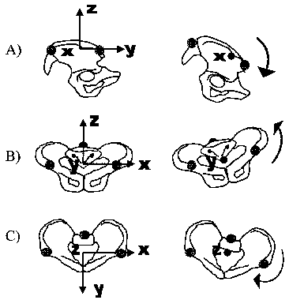The Power of a Neutral Pelvis: Why It Matters When You Stand and Walk

The truth is I overuse some phrases. “Stick out your butt”, is one of them. I am always trying to get people to change their habitual patterns. One of the main things I want people to understand is how important it is to have a neutral pelvis as a default position.
Our posture is the foundation for how we move, and at the center of that foundation lies the pelvis. Whether we’re standing still or walking, the position of the pelvis plays a crucial role in how efficiently and comfortably we move. One of the most important postural alignments to understand is the concept of a “neutral pelvis.”
What Is a Neutral Pelvis?
A neutral pelvis refers to the position where the pelvis is aligned with the natural curves of the spine. One way to look at this, though admittedly a subtle option, is the hip bones (ASIS—anterior superior iliac spines) and the pubic bone should be in the same vertical plane when viewed from the side. This alignment allows for balanced muscle engagement, reduces unnecessary strain on joints, and sets the stage for efficient movement patterns.
Why Is a Neutral Pelvis Important?
When the pelvis is in a neutral position, it acts as a stable foundation for the spine and legs. This positioning is not just about aesthetics or standing tall—it directly impacts the way weight is transferred and distributed throughout the body. Here are some key reasons why maintaining a neutral pelvis is essential:
- Optimal Muscle Function: In a neutral position, the muscles surrounding the pelvis, including the abdominals, glutes, and hip flexors, can work in harmony. This balance allows for better strength, coordination, and control.
- Efficient Movement: When walking, the pelvis naturally tilts and rotates with each step. Starting from a neutral position allows these movements to occur fluidly and in proper sequence, improving walking efficiency and reducing compensatory patterns.
- Reduced Injury Risk: An imbalanced pelvis can lead to excess strain on the lower back, hips, knees, and even the feet. By maintaining a neutral pelvis, you can help prevent common issues such as low back pain, hip impingement, and overuse injuries.
- Joint Health: Proper pelvic alignment supports even weight distribution through the spine and lower extremities, reducing wear and tear on joints and promoting long-term mobility.
Pelvic Movement During Walking

Walking is a dynamic process, and with every step, the pelvis naturally tilts and rotates. This movement is essential for shock absorption, forward propulsion, and maintaining balance. However, these natural motions can only happen correctly if the pelvis starts in a neutral position.
When you take a step, the pelvis tilts slightly downward on the side of the swinging leg while rotating toward the leading leg. This intricate coordination allows your body to move smoothly and efficiently. If the pelvis is habitually tilted forward (anterior pelvic tilt) or backward (posterior pelvic tilt), this natural rhythm is disrupted, leading to inefficient movement patterns and potential discomfort.
Anterior and Posterior Pelvic Tilt: Not Inherently Wrong
It’s important to understand that an anterior or posterior pelvic tilt is not inherently problematic. Both positions can be useful and necessary depending on the activity or movement being performed.

I teach Cat & Cow Pose in almost every class I offer. This specifically makes the pelvis move through an anterior and posterior tilt. The issue arises when these positions become the default posture rather than a conscious choice.
For example, athletes may adopt a slight anterior pelvic tilt during sprinting to enhance hip extension, while a posterior tilt might be useful in activities requiring core engagement, like gymnastics. However, for everyday standing and walking, a neutral pelvis should be the baseline.
How to Find and Maintain a Neutral Pelvis
Achieving a neutral pelvis starts with awareness and practice. Here are a few steps to help you find and maintain this position:
- Take Your Thighs Backward: We tend to lean the thighs forward which pulls on the pelvis, and almost always takes it out of a neutral position. When the legs move back and under the hips, and in line with the spine, it is much easier to establish a well aligned pelvis.
- Develop Your Glutes & Core: It isn’t hard to find a neutral pelvis if I tell you how to get there. But maintaining a well aligned pelvis requires balanced muscle tone. And not just in the glutes and abs but they are a fine place to start. You can add the inner thigh, or adductor muscles, as well.
- Practice Pelvic Tilts: Gently rock your pelvis forward and backward to explore the range of motion. Settle into the middle point where your spine feels supported and neutral.
- Be Mindful When Walking: As you walk, observe how your pelvis moves. Aim to pass through a neutral position with each step, allowing for natural tilting and rotation without locking into one position. The easiest way to accomplish this is to take shorter steps.
A neutral pelvis is the foundation for efficient movement, whether you’re standing still or walking through life. While anterior and posterior tilts have their place, maintaining a neutral pelvis as your default allows your body to move with ease and resilience.
By cultivating awareness and practicing proper alignment, you set yourself up for better posture, improved movement patterns, and long-term physical health.
